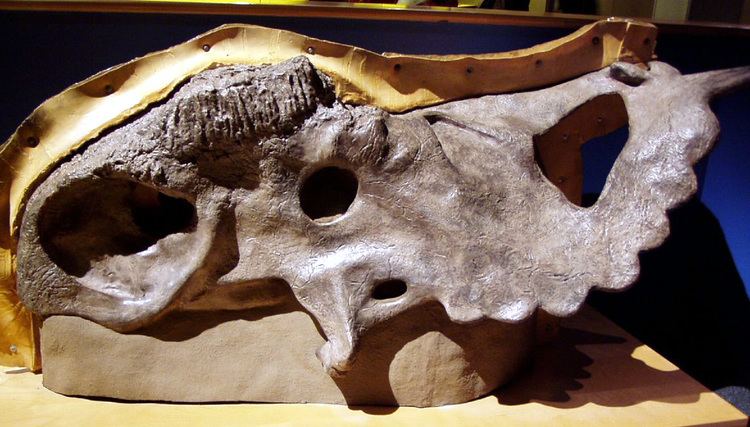 | ||
Thickness up to 762 metres (2,500 ft) | ||
The St. Mary River Formation is a geologic formation of Late Cretaceous (Campanian to Maastrichtian) age of the Western Canada Sedimentary Basin in southwestern Alberta and northwesternmost Montana. It was first described from outcrops along the St. Mary River by George Mercer Dawson in 1883, and it takes its name from the river.
Contents
- Lithology
- Thickness and distribution
- Relationship to other units
- Molluscs
- Plants
- Mammals
- Dinosaur tracks
- References
Fossils from the formation include remains of dinosaurs, as well as bivalve shells, plant fossils, and trace fossils.
Lithology
The St. Mary River Formation is generally considered to consist of two units. The lower 30–60 meters (98–197 ft) of the formation was deposited in brackish water environments, and is characterized by fine-grained sandstones, grey shales, coquinoid beds, carbonaceous mudstones and coal beds. The remainder of the formation was deposited in freshwater fluvial and floodplain environments. It is characterized by interbedded sandstone and siltstone, with minor occurrences of carbonaceous shale and coal.
Thickness and distribution
The St. Mary River Formation is part of an eastward-thinning wedge of sediments derived from the erosion of the mountains to the west. It is about 762 metres (2,500 ft) thick in the exposures along the Crowsnest and Castle Rivers, and about 457 metres (1,500 ft) thick along the Oldman River.
Relationship to other units
The St. Mary River Formation conformably overlies the Blood Reserve Sandstone, or the Bearpaw Formation where the Blood Reserve Sandstone is absent, and it is conformably overlain by the Willow Creek Formation. It extends from Glacier County, Montana to as far north as the Little Bow River in Alberta, where it grades into and intertongues with the contemporaneous strata of the Horseshoe Canyon Formation.
Molluscs
Beds of Ostrea and Corbicula shells are common in the basal, brackish water portion of the formation. The overlying freshwater beds include shells of freshwater and terrestrial molluscs. Shells of Unionidae are common in the fluvial sandstones.
Plants
Eighteen species of plant leaves were described from the St. Mary River Formation in 1949. More recent work downstream from the St. Mary Reservoir increased the total to at least 32 species. The assemblage includes remains of ferns, Ginkgo, conifers, a Trapa-like plant, and at least six types of large monocot leaves in addition to a sabaloid palm.
Mammals
The mammals of the St. Mary River Formation were described by Sloan and Russell in 1974.
Dinosaur tracks
The St. Mary River Formation has produced relatively few dinosaur fossils from its outcrops in southwestern Alberta. However, footprints and trackways have been found along the St. Mary and Oldman Rivers. More than 100 track-bearing stratigraphic units were documented in one section 177 metres (580 ft) thick, which is one of the highest densities of track-bearing layers reported from any succession. One footprint from the formation includes the first record of skin impressions from the bottom of a hadrosaur foot.
